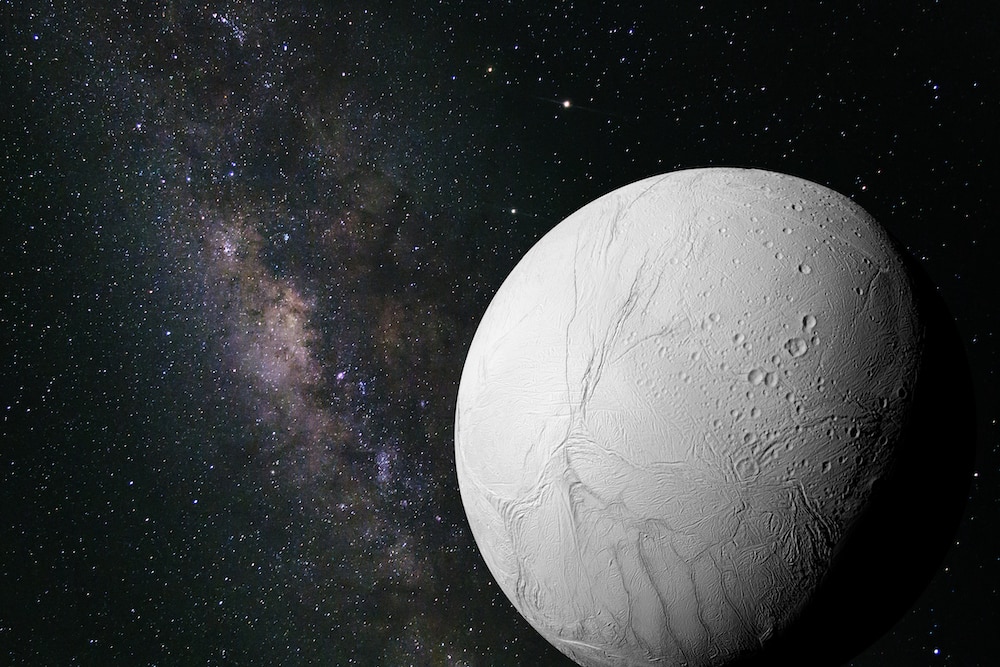Create a free profile to get unlimited access to exclusive videos, sweepstakes, and more!
Are alien oceans too freezing for life-forms?
You're about to plunge into uncharted waters.

In the search for extraterrestrial life forms, intelligent or not, the next destinations Earthlings have their eyes on are Europa, Titan, Ganymede, Callisto, and (possibly further out in the future) Enceladus — but there is just one thing that might get in the way: Every single one of them is frozen.
What could, at least hypothetically, survive on a world that doesn’t seem too different from the icy wasteland where that abomination in The Thing emerged? Something might be lurking underneath all that ice if you ask a team of researchers from UC Berkeley. These moons are thought to be hiding vast salty oceans beneath the surface, and salty water has a higher freezing point. Meaning, that water can stay liquid at temperatures which would freeze water without any salt. These cold but possibly habitable oceans could have spawned life.
When oceans are able to stay liquid, they remain stable, and stable oceans mean a higher chance for habitability. There could be many types of salts in the waters of the faraway moons that spacecraft will soon explore. The researchers tested five salts at pressures that were about three times more intense than what any form of life would experience in the Mariana Trench, which is the deepest ocean trench on this planet. That’s three thousands times Earth’s atmospheric pressure. They recently published their findings in Cell Reports Physical Science.
“The low-temperature equilibria of aqueous solutions play a fundamental role in fields from cryopreservation to astrobiology and beyond and are particularly integral to investigation of icy moons (e.g., Europa, Ganymede, Titan, Enceladus), prime candidates to find habitable environments in our solar system,” the researchers said in the study.
Spacecraft may have not landed on Europa or any other frozen moons yet, but they have taken measurements of magnetic fields, surface composition, and geological features on the surface that suggest the water beneath is salty. They have even hinted at the existence of cryovolcanoes that erupt in salty slush. Because salt water is eutectic, it freezes at much lower temperatures. Eutectoids are made of substances that freeze at one temperature and melt at another. If there is really salt water in the depths of these moons, salt will cause the liquid to freeze at a temperature lower than the freezing point of water. Something could swim in there.
What the research team wanted to find out was the lowest temperature that salty water could still remain a liquid at under extreme pressure. The experiment had actually started as a quest to figure out methods of cryopreservation for food storage and organs needed for transplants, but it was easily used to give an idea of what can be expected in alien oceans. Out of the salts that might exist on Europa, Titan, or Ganymede, the sodium chloride in seas on Earth is believed to be one of them. Magnesium sulfate and sodium sulfate are also suspected to be floating around. If anything lives on these bodies, it might have evolved to tolerate these.
Until we find out whether anything actually lives in the oceans of these mysterious moons, we only have life on our own planet to go off of. There are things that thrive in the Mariana trench despite the intense pressure. Bioluminescent dragonfish, hatchetfish and anglerfish, zombie worms, vampire squid, and other creatures that could pass for aliens can survive at these depths. The pressure in seas such as Europa’s is comparable to much shallower waters.
There are still unanswered questions. What could survive in salts other than NaCl? Also, the deepest place on Earth seems positively warm compared to the unexplored oceans in space. The average temperature of the Mariana Trench is about 34-39 degrees Fahrenheit. Compare that to Europa, with a daytime surface temperature of -225 degrees at its equator. It is possible that there are hydrothermal vents deep inside Europa, Titan, Ganymede, and Callisto that gush water heated by magma in the mantle. Right now, that can only be guessed at.
We’re going to have to wait for missions to touch down on these moons if we really want to find out what may or may not be under the ice. ESA’s JUICE (Jupiter Icy Moons Explorer) will be launching in 2023, with NASA’s Europa Clipper in 2024. NASA is also behind the Dragonfly Clipper that will head for Titan in 2027. Maybe there is an alien anglerfish somewhere?


























